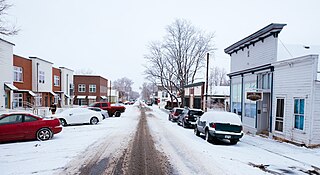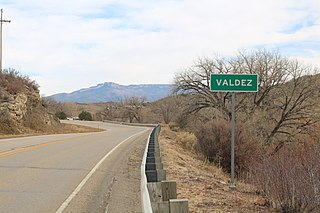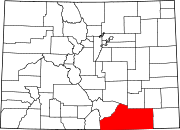
The City of Lafayette is a home rule municipality located in southeastern Boulder County, Colorado, United States. The city population was 30,411 at the 2020 United States Census.

Trinidad is the home rule municipality that is the county seat and the most populous municipality of Las Animas County, Colorado, United States. The population was 8,329 as of the 2020 census. Trinidad lies 21 mi (34 km) north of Raton, New Mexico, and 195 mi (314 km) south of Denver. It is on the historic Santa Fe Trail.

Dawson is a ghost town in Colfax County, New Mexico, United States. Dawson was the site of two separate coal mining disasters in 1913 and 1923. Dawson is located approximately 17 miles northeast of Cimarron.

The Colorado Fuel and Iron Company (CF&I) was a large steel conglomerate founded by the merger of previous business interests in 1892. By 1903 it was mainly owned and controlled by John D. Rockefeller and Jay Gould's financial heirs. While it came to control many plants throughout the country, its main plant was a steel mill on the south side of Pueblo, Colorado, and was the city's main industry for most of its history. From 1901 to 1912, Colorado Fuel and Iron was one of the Dow Jones Industrials. The steel-market crash of 1982 led to the decline of the company. After going through several bankruptcies, the company was acquired by Oregon Steel Mills in 1993, and changed its name to Rocky Mountain Steel Mills. In January 2007, Rocky Mountain Steel Mills, along with the rest of Oregon Steel's holdings, were acquired by EVRAZ Group, a Russian steel corporation, for $2.3 billion.

Wehrum is an abandoned coal mining company town in Buffington Township, Indiana County, Pennsylvania, United States, that thrived for a time during the early 20th century. The mine upon which it was entirely dependent closed in 1929, and the last known inhabitants left in 1934. Essentially all that remains of Wehrum today are shadowy remnants of some of the streets and various building foundations hidden in the woods. Wehrum is now one of the ghost towns included in Pennsylvania's Ghost Town Trail.

Carpenter is an extinct coal mining town located in Mesa County, Colorado, United States, twelve miles northeast of Grand Junction at the end of an extension to 27¼ Road. The townsite is located at 39.1944°N 108.4733°W, at an elevation of 5,808 feet (1,770 m). The Carpenter post office operated from June 11, 1890, only until August 3, 1891.

Cardiff is a ghost town in Livingston County, Illinois, United States. Founded as a coal mining town in 1899, it boomed in its first few years. The closure of the mine in 1912 soon led to the community's demise. It is located in Round Grove Township, between the villages of Campus and Reddick.

The Steelworks Museum is located in Pueblo, Colorado. Operated by the Steelworks Center of the West, the museum is in the historic Minnequa Steel Works Office Building and Dispensary of the Colorado Fuel and Iron Company.
The Ghost Town Trail is a rail trail in Western Pennsylvania that runs 36 miles (58 km) between Black Lick, Indiana County, and Ebensburg, Cambria County. Established in 1991 on the right-of-way of the former Ebensburg and Black Lick Railroad, the trail follows the Blacklick Creek and passes through many ghost towns that were abandoned in the early 1900s with the decline of the local coal mining industry. Open year-round to cycling, hiking, and cross-country skiing, the trail is designated a National Recreation Trail by the United States Department of the Interior.

Spring Canyon, also called Storrs, is a ghost town in Carbon County, Utah, United States. In 1912, Jesse Knight purchased 1,600 acres of coal land and began developing a mine and a company town. Knight named the town Storrs, after the mine superintendent. The name of the town was changed to Spring Canyon in 1924. 1,000 tons of coal per day were mined from 1924 to 1943, and during World War II, coal production peaked at 2,000 tons of coal per day. By 1946, the need for coal diminished, and people began to leave. By 1969, Spring Canyon was abandoned.

John Cleveland Osgood was a self-made man who founded the Colorado Fuel and Iron Company and Victor-American Fuel Company but has been referred to as a robber baron. He also created Redstone, Colorado.
Cambria (1889–1928) is a ghost town located in the Black Hills of Weston County, Wyoming, United States. It was a successful coal mining town for decades.

Brodhead is an extinct coal mining town located in Las Animas County, Colorado, United States. The townsite is located at 37.4108°N 104.6764°W at an elevation of 6,919 feet (2,109 m). The Brodhead post office operated from August 14, 1902, until April 29, 1939.

Valdez is an unincorporated community and a census-designated place (CDP) located in and governed by Las Animas County, Colorado, United States. From 1907 to 1960, Valdez served as a company town for Colorado Fuel & Iron and its Frederick coal mine, the company's most productive and second largest. The population of the Valdez CDP was 46 at the United States Census 2020. The Trinidad post office serves the area.

Primero is a ghost town in Las Animas County, Colorado, United States. The community was a company coal mining town for the Colorado Fuel and Iron Company during the early 20th century.

Tercio is a ghost town and former coal mine in Las Animas County, in the U.S. state of Colorado. The GNIS classifies it as a populated place. A post office, called Tercio, was established in 1902 and remained in operation, until 1949. The community was the third coal mining community established by the Colorado Fuel and Iron company, hence the name.

Franceville was a coal mining town and railroad post office in eastern El Paso County, Colorado, about five miles from the town of Falcon and twelve miles east of Colorado Springs. The Franceville post office operated from November 2, 1881, until May 14, 1894. The town was located on land owned by Matt France. There were 120 people in the town in 1885.

Berwind is a ghost town in Las Animas County, Colorado, nestled in Berwind Canyon 3.1 miles (5.0 km) southwest of Ludlow and 15 miles (24 km) northwest of Trinidad. The settlement was founded in 1888 as a company town for the Colorado Coal & Iron Company and, from 1892, was operated by the Colorado Fuel & Iron Company. It was a battle site in October 1913 and April 1914 during the Colorado Coalfield War, housing a Colorado National Guard encampment during the latter stages of the conflict.
Saint Vrains is a ghost town in Weld County, Colorado, United States.
Dick is an extinct town in Weld County, in the U.S. state of Colorado.

















